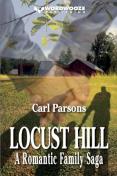BKMT READING GUIDES
Locust Hill: A Romantic Family Saga
by Carl Parsons
Published: 2025-02-03T00:0
Paperback : 190 pages
Paperback : 190 pages
0 members reading this now
0 club reading this now
0 members have read this book
0 club reading this now
0 members have read this book
City girl falls in love with country boy in the family saga Locust Hill. Carl Parsons' third noveldetails the struggles of an independent, small acreage farm family in the Mid-Ohio Valley of West Virginia. With wife Cassandra as the narrator, the novel recounts her discovery of a different world ...
No other editions available.
Jump to
Introduction
City girl falls in love with country boy in the family saga Locust Hill. Carl Parsons' third noveldetails the struggles of an independent, small acreage farm family in the Mid-Ohio Valley of West Virginia. With wife Cassandra as the narrator, the novel recounts her discovery of a different world just outside her West Virginia hometown, a quaint rural village where people survive and maintain their community by helping one another. During their life together, Cassandra learns that her husband, Jim Russell, is the very embodiment of this spirit.
Editorial Review
No Editorial Review Currently AvailableExcerpt
Excerpt from Chapter 1 of Locust Hill:On one date Jim asked, “Have you made any plans yet for college and a career?
“For college, yes,” I said. “I’m going to WVU in the fall, but for a career, not really. I haven’t gotten that far yet. What about you? I suppose you’ll stick with farming.”
“For sure, I will,” he said. “That much is certain, but I also want to get a botany degree.” Then he paused a bit before asking, “Do you think you would like life on a farm?”
Uh-oh, I thought. What is this leading to? “Not sure,” I replied. “Never really thought about it. I am a city girl, you know.”
“But you should think about it,” he said. “I think you’d be perfect on a farm.” I could detect that sly smile of his trying hard to curl his lips. But he fought it off and then he added, “Because you’re sturdy.” ...
Discussion Questions
From the author:1. What is the setting (time and place) for the novel? How do you know the time? How do you know the place? How does the town in which Cassandra lives differ from the rural village where Jim lives? Is the difference just a matter of location?
2. Cassandra quickly distinguishes herself for us from Jim. How do they differ at the beginning of the novel? What does Cassandra later discover that explains much of Jim’s behavior and appearance?
3. What do we learn about Jim and Locust Hill from the evening at El Caballito? Is Jim typical of Locust Hill residents?
4. On her first visit to the Russell family’s farm, what are the most telling impressions that Cassandra forms? About Jim’s family? About farm life? About Jim and Locust Hill? What is the biggest surprise for her?
5. Why does Cassandra agree to accept Jim’s proposal? What is unusual about the proposal? What does it tell us about Jim? And what does her acceptance tell us about Cassandra?
6. What impressions does Cassandra form while attending her first Mass at St. Benedict’s? Why does she agree so quickly to convert to Catholicism? What impact does this decision have on her relationship with her mother?
7. How do Jim and Cassandra manage their college years and early years of marriage? How helpful are Jim’s Uncle Ed and his wife Edith?
8. Explain the importance of the episode at the Nestlerode’s farm? Why does Cassandra later question Jim about the agreement they made with the Nestlerodes?
9. Explain the crisis that affects Locust Hill, which Jim and Cassandra discover from visiting Will Clement’s cattle farm? How does it impact all of Locust Hill? How does Cassandra convince Travis Lowery to act on the crisis?
10. At his wake, Cassandra speaks of Jim as the spirit of Locust Hill. Is this true? Explain. Characterize her married life with Jim. How does she change during the novel? How does Jim change?
Notes From the Author to the Bookclub
Author’s Answers for the Discussion Questions: Disclaimer: Be wary of what authors say about their own works. The literary critics William Wimsatt and Monroe Beardsley in their work The Verbal Icon (1954) warned against simply accepting what authors claim when interpreting their works. Wimsatt and Beardsley point out that what authors intended to communicate may not, in fact, be supported by the text. And in the end, what the text of the poem, novel, or essay says must prevail. You’ve been warned! 1. We aren’t told either the time or the place, except that we have a town named Parkeston and a rural village named Locust Hill and that they are in West Virginia. As for the time, a good guess is, no later than the mid-1960s. Note that in their senior year Jim and Cassandra are studying trigonometry Calculus isn’t available to them yet. Also, the crisis chapter is based on a real incident that occurred in the 1990s, which corresponds closely to the 35 years of marriage that Cassandra mentions on page 150. I based Parkeston on Parkersburg, West Virginia, where I grew up, and Locust Hill on a composite of Lubeck, Washington, and New England Ridge, which are still mostly rural communities to the southwest of Parkersburg. At first Cassandra thinks living in Parkeston makes her more sophisticated than Jim, whose community is very rural, even though we never see anything in Parkeston that is like big city life. But such is Cassandra’s initial prejudice, which explains in her mind most of the difference between the two locations rather than the actual distance that separates them. Finally, Cassandra concedes that for her Locust Hill is a completely unexpected wonder yet located so close to her own home. 2. When we first meet Cassandra, she is very much concerned with her own appearance and social status. In fact, she has such a distorted view of social status that she believes dating Frankie Preston helps her cement a higher social acceptability than she might otherwise, whereas, as Jim later tells her, everyone else understood Frankie as a sexual predator (to put the matter in current parlance). She describes her own appearance in mostly flattering terms, and other characters react to her beauty as well. The main thing that Cassandra discovers about Jim is how the death of his father changed life for him and his mother and sister. She quickly appreciates the depth of character that Jim has developed in becoming the head of the family while still in high school. 3. The El Caballito episode provides some comic relief and gives us a chance to see Locust Hill residents at play. The incongruity of a Mexican cantina set up in what had been a service station in a West Virginia rural village only adds to the fun, as does meeting Wanda Williams, Jim’s neighbor, former classmate, and now waitress and mock señorita. Jim understated dress (no fancy buckles or belts) and manners indicate that he is likely more practical than the other Locust Hill residents. 4. Upon her first visit to the Russell farm, Cassandra experiences a hard day of labor that she finds both exhausting and exhilarating. It proves further that more than distance distinguishes Locust Hill from Parkeston. Locust Hill represents a completely different way of life. Perhaps her biggest discovery is that farmwork provides a satisfaction she has not previously experienced. But she is also concerned about the fragility of life for the Russells, who must live with a thin margin for error. Cassandra is also impressed at how organized the work is, showing again how practical Jim is. 5. Cassandra accepts Jim’s proposal because she has come to realize that he offers her something no other boy has—namely, truth in life rather than social and personal pretense. It is the practicality of the Jim’s proposal, made well in advance of anticipated fulfillment, that is so striking about it, but is nevertheless just more evidence of Jim’s nature. With her acceptance, Cassandra is showing us that she is changing, starting to become more aware of what a romantic relationship should really be. But next she must convince her parents of its value! 6. When Cassandra first attends Mass at St. Benedict’s, she is a bit overwhelmed by the Latin liturgy and the complexity of the church’s symbolic interior. She tells us how different the whole experience is from her worship with her mother in a Baptist church. “So much to know!” she says at one point. And she feels a bit left out, despite Jim’s prompts, until the family goes to brunch afterwards with Jim’s Uncle Ed and Aunt Edith. Cassandra agrees to convert to Roman Catholicism as another way of showing her full commitment to Jim, even though she knows already that her mother strenuously objects, to the point of saying that her daughter is “lost.” 7. The couple manages to attend college by enrolling in a local community college while Jim continues to work on the farm with the part-time help of a friend. Cassandra works in a grocery store. Later, once they start to have children and so outgrow the small farmhouse in what they come to call the heritage farm, Jim and Cassandra rent rooms from Uncle Ed and Aunt Edith in exchange for a reduction in the price of the feed to Uncle Ed’s dairy cows. 8. The Nestlerode episode is a turning point in the novel because it gives Jim the idea for a local farmers’ alliance. But Cassandra senses that Jim has taken advantage of the Nestlerodes’ desperation just because he wants to sign a supplier contract with a grocery chain. Mixing their sexual banter with his explanation, Jim points out the advantages of the agreement for the Nestlerodes. 9. After years of success with their farmers’ alliance, the Russells face their greatest challenge—the pollution of the aquafer in Locust Hill by a factory located in the bottom land along the Ohio River. They make the discovery when a friend, Will Clement, begs them to come to his farm and see what is happening to his cattle. As the investigation unfolds, it becomes clear that all of Locust Hill is affected through its use of LH Water District services. When Jim must leave to manage the crisis with the grocery chains the alliance supplies, it falls to Cassandra to deal with Travis Lowery, the chair of the LH Water District Board of Directors. He tries to deny the crisis even exists, but Cassandra appeals to his honor and reputation within the community to convince him that he must act. 10. Cassandra has indeed come to see Jim as the spirit of Locust Hill, a place of neighbors and keepers of the village, a place that to some extent has resisted change in order to preserve a kinder, simpler life more in tune with its natural setting. To Cassandra, Jim seems masterful in this setting. He knows the soil, the season, and the crops. Even the weeds seem to be his friends! In this environment and with the struggles of small acreage farming, the couple rear five successful children and create a successful business that in turn helps other farmers to stay in business. Not only are they successful and parents and business people, they are devoted to each other throughout a long marriage. During the novel, Cassandra quickly loses the shallowness of character she at first displays because Jim gives her purpose in life, something and someone to work with and live for. For his part, Jim does not change to the degree that Cassandra does. His major life transformation already occurred when his father died and he had to become head of the family.Book Club Recommendations
Recommended to book clubs by 0 of 0 members.
MEMBER LOGIN
BECOME A MEMBER it's free
Book Club HQ to over 90,000+ book clubs and ready to welcome yours.
SEARCH OUR READING GUIDES
Search
FEATURED EVENTS
PAST AUTHOR CHATS
JOIN OUR MAILING LIST
Get free weekly updates on top club picks, book giveaways, author events and more
Get free weekly updates on top club picks, book giveaways, author events and more
Please wait...








